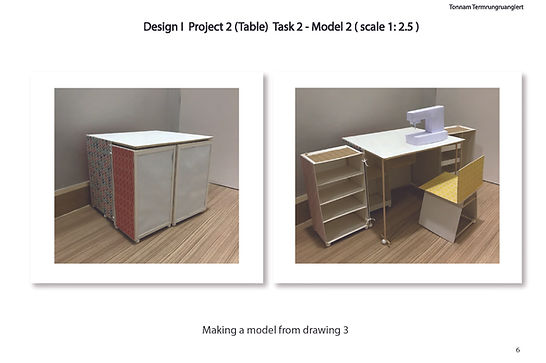

Portable Sewing Station
Part 1
Meet Ms.Nui , A Cloth Repairer
I initiated the project titled "Portable Sewing Station" by conducting an interview with Ms. Nui, an experienced cloth repairer employed at a cooperative store within Chulalongkorn University. Ms. Nui's work area consists of a single table situated in a corner of the shop. During the interview, captured on video, she shared her insights on the requirements for an ideal sewing station, emphasizing the importance of an ergonomic approach.
Part 2
Prototype 1
Following the interview with Ms. Nui, I proceeded to create the initial prototype of the sewing station using a cardboard model. The resulting station takes the form of a foldable table design. To accommodate Ms. Nui's needs, the table can be extended, providing additional space for her work. Furthermore, the station incorporates two cabinet sides intended for storing sewing tools and facilitating the organized arrangement of cloth materials.


The chair plays a crucial role in ensuring ergonomic comfort within the sewing station. Recognizing this, I have also taken on the task of designing a chair that can be conveniently stored inside the sewing station when it needs to be folded back into a compact form. This feature enables easy mobility and the option to move the station to different locations as needed. Additionally, I have conducted experiments with designing a canopy for the station, allowing it to be utilized for outdoor work when desired.
Prototype 2
Building upon the foundation of the first prototype, I have further refined the design of the sewing station. One notable adjustment is the transformation of its overall shape into a cube, enhancing its compactness and instilling a sense of minimalistic design.


Here is the progress of the canopy design. The design incorporates canopy-supported columns that can be extended from the cabinets and the chair. To provide shade when required, the canopy cloth is designed to be manually attached to the columns. This allows for easy installation and removal of the canopy, providing convenient shading whenever it is needed.
Part 3
Final Prototype and Drawings
The ultimate design of the sewing station takes the shape of a closed portable box, specifically designed to be easily moved by a woman. As for the canopy, it has been meticulously designed to be set up using a tube mechanism located inside the cabinet and positioned behind the chair. This tube utilizes a telescopic system, allowing it to be extended or compressed as needed, ensuring convenient and flexible canopy setup.


The dimensions of the station form a cube, measuring approximately 80 x 80 x 75 cm.
Final 1:1 Prototype
Dedicating two weeks to construct the final prototype of the Portable Sewing Station at a 1:1 scale. The accompanying set of photos captures the station's evolution, showcasing its transition from a closed box to a fully opened configuration. Additionally, to safeguard the station from dust and maintain its clean condition, I have crafted a wrapping outer cloth specifically designed for this purpose.





To bring the prototype to life, my initial step was to construct a wooden framework. I meticulously assembled the wooden pieces, securing them firmly with bolts to ensure structural integrity. Once the framework was complete, I proceeded to wrap it with two patterns of colorful cloth, giving the station an attractive and eye-catching appearance. Moving on to the table section, I crafted a chair and details such as incorporating a functional drawer.
With Ms. Nui's emphasis on ergonomic considerations during sewing work, I meticulously took into account the dimensions of the station to ensure a comfortable working posture. By carefully designing the station, Ms. Nui would no longer need to strain her shoulders significantly while using it. When I presented the final result to Ms. Nui, she expressed her desire to utilize the station in outdoor spaces, enjoying the serene ambiance of nature while engaged in her sewing activities.
